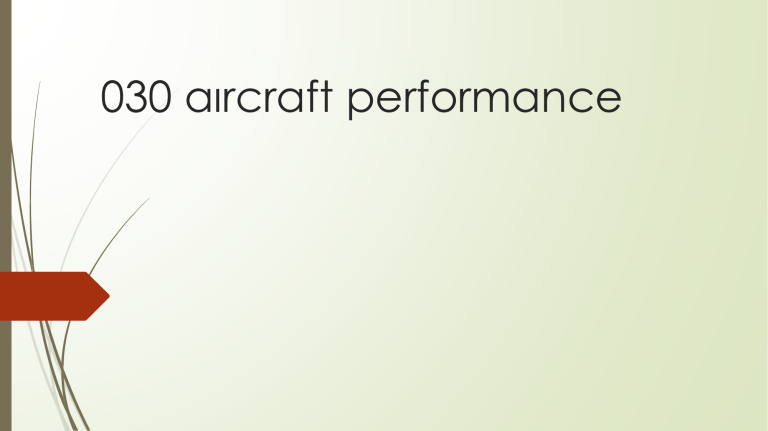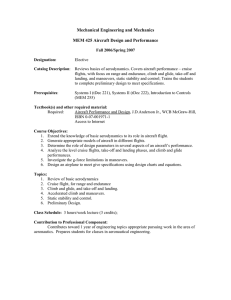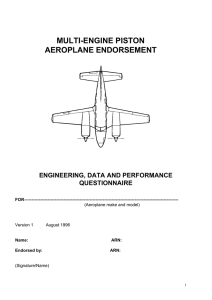
030 aırcraft performance 031 MASS AND BALANCE Lesson Objectives At the conclusion of this lesson you will… ⚫Understand why weight and balance is critical to safety of flight ⚫Be familiar with the terms associated with weight and balance ⚫Be familiar with the methods of calculating weight and balance ⚫Understand the effect weight and balance has on aircraft performance MASS is the amount of an item inside a body. This is expressed in kilograms or pounds depending on the system used. FaXA=FbXB Weight Terms � Empty Aircraft � Standard Empty Weight – weight of a standard airplane including unusable fuel, full operating fluids and full oil � Basic Empty Weight – Standard Empty Weight plus optional equipment � Starting Point of Weight and Balance > > > > Fire extinguishers Pyrotechnics Emergency oxygen equipment Supplementary electronic equipment BEM Weight Terms � Useful Load – total usable fuel, passengers, and cargo � Payload – passengers and cargo � What essentially could be revenue generating Traffic Load Variable Load Dry Operating Mass (DOM) � Is the total mass of the aeroplane ready for a specific type of operation excluding all usable fuel and traffic load. The mass includes items such as: � 1. Crew and crew baggage � 2. Catering and removable passenger service equipment � 3. Potable water and lavatory chemicals � 4. Food and beverages � BEM + Variable Load =Dry Operating Mass STRUCTURAL LIMITATIONS � MaxIMum Structural TaxI Mass(MSTM) Is the structural lImItatIon on the mass of the aeroplane at the commencement of taxI. � MaxIMum Structural Take-Off Mass(MSTOM) The maxIMum permISSIBLE total aeroplane mass at the start of the take-off run. Maximum Structural Landing Mass(MSLM) - The maximum permissible total aeroplane mass on landing under normal circumstances. Maximum Zero Fuel Mass (MZFM) The maximum permissible mass of an aeroplane with no usable fuel. CALCULATIONS + BasIc Empty WeIght + VarIable Load + TraffIc Load + Usable Fuel � =Ramp WeIght � - Fuel used for start, taxI and run-up � = Take-off WeIght � - Fuel used for flIght � = LandIng WeIght WeIght Terms � Fuel � Usable Fuel – fuel whIch can be used for flIght plannIng � Unusable Fuel – fuel whIch cannot be use In flIght due to fuel tank desIgn Fuel DefInItIons � Block Fuel (bulk fuel or ramp fuel) � Start,Run up,and TaxI Fuel � Take off Fuel � TrIp Fuel � LandIng Fuel -ContIngency Fuel -Reserve Fuel -ALTERNATE FUEL -EXTRA FUEL Usable Fuel � LandIng Fuel + TrIp Fuel = Take-Off Fuel � Take-Off Fuel + Start and TaxI Fuel = Ramp Fuel � OperatIng Mass (OM) -Is the DOM plus fuel but wIthout traffIc load. � From DOM, the aIrcraft can be brought up to OM by loadIng the Take-Off Fuel (TOF) but none of the passengers, baggage, ballast, and cargo. � DOM+TOF =OM � BEM + VL + TOF = OM Zero Fuel Mass (ZFM) � Is DOM plus traffIc load but excludIng fuel. From DOM, the aIrcraft can be brought up to ZFM by loadIng all of the passengers, baggage, ballast, and cargo but none of the fuel. � DOM + TraffIc Load = ZFM � BEM + VL + TraffIc Load =ZFM CG LOCATION CalculatIng The BEM CG LONGITUDINAL STABILITY CG POSITION IN FLIGHT 1-FUEL CONSUMPTION 2-FLAP EXTENSION/RETRACTION 3-GEAR EXTENSION/RETRACTION 4-CARGO MOVEMENT FUEL CONSUMPTION FLAPS EXTENSION/RETRACTION LANDING GEAR DESIGN CARGO CG LocatIon MSTOM MZFM+TAKE-OFF FUEL=TOM MSLM+TRIP FUEL =TOM THREE CG POINTS THAT MUST BE CALCULATED � Take off Mass(TOM) � LandIng Mass(LM) � Zero Fuel Mass(ZFM) Stability Stability Stability is the tendency of an object (airplane) to return to its state of equilibrium once disturbed from it. There are two kinds of stability: static and dynamic. • Static stability is the initial tendency of an object to move toward or away from its original equilibrium position. • Dynamic stability is the position with respect to time, or motion of an object after a disturbance. Static Stability Positive Static Stability If an object has an initial tendency toward its original equilibrium position after a disturbance, it is said to possess positive static stability. Static Stability Negative Static Stability Is the initial tendency to continue moving away from equilibrium following a disturbance. Static Stability Neutral Static Stability Is the initial tendency to accept the displacement position as a new equilibrium. Static Stability Positive-Neutral-Negative Dynamic Stability Positive Dynamic Stability After it is released, it will roll back to the bottom and up the other side. It will roll back and forth, oscillating less and less about the equilibrium position until it finally came to rest at the bottom of the bowl. It possesses positive dynamic stability. Dynamic Stability Neutral Dynamic Stability If the ball oscillates about the equilibrium position and the oscillations never dampen out, it possesses neutral dynamic stability. Dynamic Stability Negative Dynamic Stability If, somehow, the ball did not slow down, but continued to climb to a higher and higher position with each oscillation, it would never return to its original equilibrium position, depicts negative dynamic stability. Maneuverability The quality of an airplane that permits it to be maneuvered easily and to withstand the stresses imposed by maneuvers. It is governed by the airplane’s weight, inertia, size and location of flight controls, structural strength, and powerplant. It too is an airplane design characteristic. Controllability The capability of an airplane to respond to the pilot’s control, especially with regard to flightpath and attitude. It is the quality of the airplane’s response to the pilot’s control application when maneuvering the airplane, regardless of its stability characteristics. Flight Controls and Effectiveness As the CG moves toward the fwd lImIt � StabIlIty � ControllabIlIty � ClImb � TrIm Drag (deflectIon of the elevator) � WIng LoadIng Increase � Stall Speed � Range and Endurance � LandIng Speed As the CG moves toward the AFT lImIt � StabIlIty � ControllabIlIty � ClImb � TrIm Drag � WIng LoadIng decrease � Stall Speed SpIn � Range and Endurance � LandIng Speed EFFECT OF OVERLOADING � • If MaxImum Take-off Mass (MTOM) Is exceeded � take-off run � clImb performance � aIrspeed � stall speed � fuel consumptIon. � range. � landIng speed &landIng run. � Heavy brakIng, damaged tyres. CG ENVELOPE AIRCRAFT PERFORMANCE FUnDAMENTAL POF DYNAMIC PRESSURE AEROPLANE SPEEDS IAS CAS EAS TAS GS MACH NUMBER LIFT Lift increases when Extending flaps,slats,slots Pulling the sticks,Increasing Aoa Increasing thrust TOTAL DRAG EFFECT OF MASS THE EFFECT OF FLAP STEADY CLIMBING FLIGHT STEADY DESCENDING FLIGHT THE GLIDE AEROPLANE PERFORMANCE CLASSES 98 STAGES OF FLIGHT � Four stages of flIGhts are consIdered. 1. Take-off 2. ClImb and CruIse 3. Descent 4. LandIng 99 TAKE OFF 100 TAKE OFF The Take-Off Performance of the aeroplane needs to be compared to the runway and surroundIng obstacles In the exIstIng condItIons prIor to actually takIng off. Take-off 101 Brake relase point Rotatio n point Ground Roll (Take-off Roll) Airborne Section (Initial Climb) The Take-off stage flight is defined as being from the brake relase point until the aircraft reaches a specified height. (screen height). 102 Take-off � Take off or Ground Roll : From brake release untIl LIft-off (VLO) � InItIal ClImb: From lIft off untIl the screen heIght. TODR: The distance from brake release until the screen height VLO BRP Take-off Roll TODR – Take-off Distance Required Initial Climb Take-off (Dıstance Avaılable) 103 TORA: The length of runway declared avaIlable and suItable for the ground run of an aeroplane. STOPWAY: A defIned obstacle free rectangular area on the ground at the end of TORA the same wIdth as the assocIated runway prepared as a suItable area In whIch an aeroplane can be stopped In the case of an abandoned take-off. CLEARWAY: A defIned rectangular area on the ground or water under the control of the approprIate authorIty, selected or prepared as a suItable area over whIch an aeroplane may make a portIon of Its InItIal clImb to a specIfIed heIght. The clearway Is beyond TORA In the dIrectIon of the extended centre lIne. TODA: TORA + Length of Clearway or 1.5 x TORA Take-off (Dıstance Avaılable) 104 107 Factors affectıng Take-off (Mass) MASS Increases � Increase InertIa, reducIng acceleratIon � Increase wheel load, reducIng acceleratIon Increase Take-off dIstance � Increase Take-off speed 10% increasing mass 20% increase take-off distance Also reduces initial climb angle 108 Factors Effectıng Take-off (DensIty) � DensIty decreases � Reduced thrust and therefore accelAratIon � Increases TAS of Take-off � Reduces InItIal clImb angle HIGH, HOT and HUMID condItIons DECREASE AIrcraft Performance Factors Effectıng Take-off (Wınd) 110 The affect of either a headwind or a tailwind can be quite marked on the take-off distance. � HeadwInd Reduces ground speed for a given IAS and increase initial climb angle. DECREASES TAKE-OFF DISTANCE Factors Effectıng Take-off (WInd) 111 � TaIl WInd Increase the ground speed for gIven IAS and reduce the InItIal clImb angle. INCREASE THE TAKE-OFF DISTANCE Factors Effectıng Durıng Take-Off (Slope) 112 The slope of a runway affects the take-off dIstance: Downslope The downslope wIll assIst In the accelAratIon process and thus decrease the take-off dIstance. Upslope The upslope wIll counter the acceleratIng force and wIll cause an Increase In the take-off dIstance. For every 1% slope the take-off dIstance affected by 5% or factor of 1.05 RUN WAY SLOPE 115 Factors Effectıng Take-Off (Surface) � Grass runways, Increase the wheel drag and Increase the take-off dIstance � Water, snow and slush surface, Increase wheel drag and create spray drag (precIpItatIon drag) whIch wIll Increase the take off dIstance. � Water, Ice and slush contamInated runways decrease the wheel frIctIon. � ContamInated runways may also lead to engIne faIlure, dIrectIonal control dIffIcultIes are structural damage. 116 Factors Effectıng Take-Off (Weather) � Heavy raIn, can Increase drag and decrease lIft � WIndshear Is rapId change In wInd speed / dIrectIon. ThIs may cause performance loss. WIND SHEAR Factors Effectıng Take-Off (Flap Settıngs) 118 Small Flap angles decrease take-off dIstance and decrease the clImb angle. CLIMB BasIc AerodynamIcs � An aIrcraft possesses a steady clImb capabIlIty by convertIng propulsIve energy In excess of that requIred to maIntaIn steady level flIght Into potentIal energy. � An aIrcraft can eIther be clImbed steeply at a low aIrspeed, or be clImbed at a hIgher aIrspeed at a shallower angle. BasIc AerodynamIcs MaxImum ANgle of ClImb (Vx) If the aIrspeed Is too low or too hIgh, all of the power or thrust avaIlable wIll be needed to overcome the drag, thus reducIng an aIrcraft's clImb capabIlIty to zero. MaxImum Angle of ClImb. - ThIs Is achIeved when an aIrcraft gaIns the most altItude In the shortest horIzontal dIstance covered, I.e. best gradIent. ThIs occurs when It Is flown at a relatIvely low aIrspeed, and gIves good ground obstacle clearance. MaxImum Rate of ClImb (Vy) MaxImum Rate of ClIMb ThIs Is achIeved when an aIrcraft gaIns the most altItude In the shortest tIme. ThIs occurs when It Is flown at a small angle of clImb and hIgh aIrspeed. a Forces IN a StraIght Steady ClImb With increasing angles of climb the amount of lift required steadily decreases, whilst the thrust requirement increases. ClImb Speed The clImb can be defINed by usIng the followIng two speeds: Vx -The maxImum gradIent of clImb speed. Vy - The maxImum rate of clImb speed. Factors AffectIng ClImb Performance The clImb performance wIll be affected by certaIn varIables: WeIght Any change In aeroplane weIght wIll affect: ✔The clImb gradIent ✔The rate of clImb ✔The drag Both the climb gradient and rate of climb speeds decrease as the weight increases. With an increase in weight more induced drag is produced. This will move the power required curve upwards. Because the power available stays the same this means that there is a reduction excess power which accordingly decreases the climb performance. Factors AffectIng CLImb Performance WInd HeadwInd - Increases the effectIve clImb angle TaIlwInd - Decreases the effectIve clImb angle Factors AffectIng ClImb Performance ConfIguratIons Flaps - Use of the flaps Increases both lIft and drag. Any lIft Increase does not Influence the clImb; an Increase In drag reduces the clImb performance. The advantage of usIng flap Is the reductIon In the stallIng speed. LandIng Gear - The clImb gradIent decreases when the landIng gear Is In the down posItIon. Factors AffectIng ClImb Performance CeIlIng � As an aeroplane clImbs eventually the gradIent and the rate of clImb decrease to zero. ThIs Is known as the absolute ceIlIng. � ThIs wIll Increase wIth decreasIng aeroplane mass. � ThIs Is not a practIcal altItude for the aeroplane to use so most flIght manuals offer an aeroplane servIce ceIlIng. ✔ Absolute CeIlIng - The pressure altItude where the rate of clImb Is zero. (The maxImum heIght AMSL at whIch an aIrcraft can maIntaIn level flIght under standart atmospherIc condItIons) ✔ ServIce CeIlIng - The pressure altItude where the rate of clImb Is a defIned value: (The hIghest altItude at wHIch an aIrcraft can maIntaIn a steady rate of clImb of 100 fpm) GENERAL PERFORMANCE CRUISE Forces In the CruIse For constant speed level flIght In the cruIse the forces shown In the dIagram below must equalIse. L T D W Lift – Weight : causes large pitch down moment Endurance / Range Endurance - The tIMe that an aeroplane can fly on a set amount of fuel. Range - The dIstance that an aeroplane can fly on a set amount of fuel. SpecIfIc Range for Jet Aeroplanes Fuel flow In a turbojet Is SFC multIplIed by thrust requIred, the specIfIc range equatIon: SpecIfIc Range = (TAS) / (SFC x Thrust RequIred) For a jet aeroplane Thrust equals Drag and for a propeller aeroplane the power avaIlable must equal the power requIred. In real terms the SR depends upon the engIne effIcIency and the aIrframe effIcIency. JET PISTON PROPELLER Factors AffectIng Range (WIND) MaxImum range speed Is affected by the change In groundspeed and the dIstance flown. HEADWIND ✔Headwind - A higher maximum range speed is required. Thus the ground distance travelled will be less. AILWIND ✔Tailwind - A lower maximum range speed is required. The ground distance travelled will be more. Factors AffectIng Range (WEIGHT) � Increased weIght Increases the drag and power. � The greater the thrust the greater the fuel flow requIred whIch wIll decrease the SR. WEIGHT OR MASS WIND � DOES NOT AFFECT ENDURANCE � BECAUSE THE HORIZONTAL POSITION OF THE AEROPLANE IS IRRELEVANT FOR ENDURANCE GENERAL PERFORMANCE DESCENT StraIght Steady Descent (DIve) Steady GlIde GRAPHS The Effect of the LIft/Drag RatIo on GlIde Performance The Effect of the LIft/Drag RatIo on GlIde Performance the mInImum drag speed produces the best glIde performance, flIght at any other speed wIll reduce the lIft/drag ratIo, and consequently Increase the angle of glIde. ThIs wIll reduce the aIrcraft's glIde performance, and reduce the overall glIde dIstance. The Effect of a Steady WInd on GlIdE Performance SUMMARY The followIng poInts summarIse the glIde: ⮚ Increased weIght Increases the forward speed of the aeroplane. The lIft and drag are consequently Increased and so the lIft/drag ratIo remaIns constant. Thus: ✔ The glIde angle remaIns constant. ✔ The aeroplane wIll descend at a hIgher speed whIch Increases the rate of descent. ⮚ If the aeroplane descends at a constant IAS ✔ Both the gradIent and pItch angle are constant GENERAL PERFORMANCE LANDING LANDING Airborne Section Touch down point Landing Roll Landing Distance Required VREF Class B/C Aeroplane VREF ≥ 1.3 VSO Force DurINg LandIng WeIght / LIft ⮚ LIft wIll need to be reduced to zero ⮚ The weIght of the aeroplane can be balanced by ground through the wheels ⮚ LIft can be destroyed by usIng the flIght and ground spoIlers Speeds


